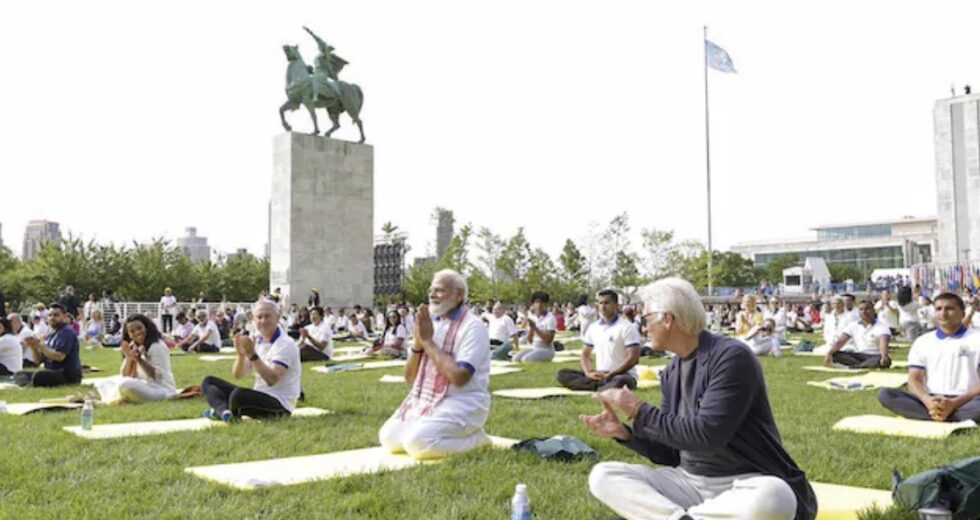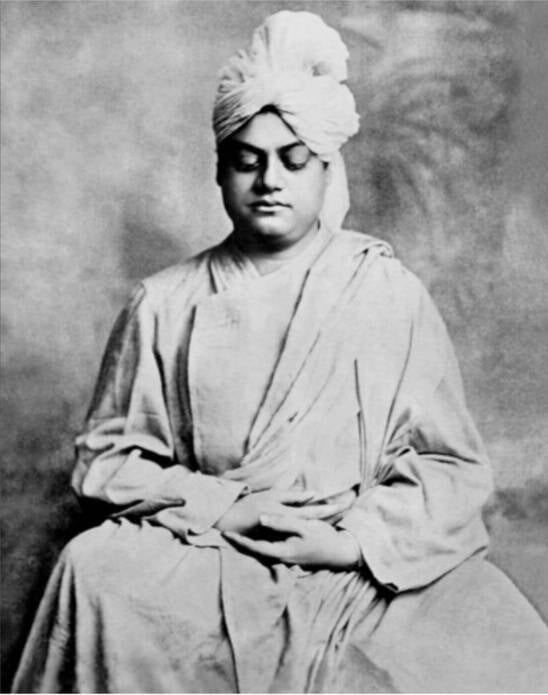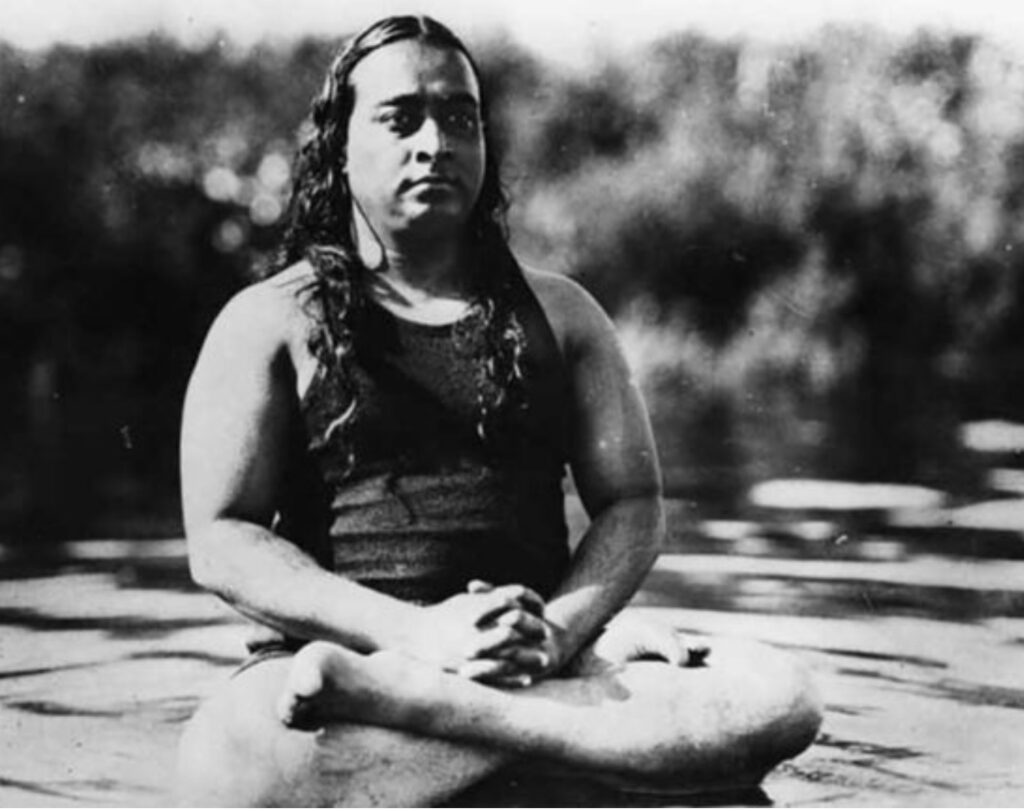Modi Inaugurates Yoga Day at UN Among Galaxy of Stars
June 22nd, 2023
SB VEDA
<CALCUTTA>
It is fitting that the 9th annual International Yoga Day was led by Prime Minister Narendra Modi on June 21st, 2022, the first day of his official state visit to the United States – the highest form of reception given to a visiting world leader. Indeed, it was through Shri Modi’s efforts that the United Nations declared June 21st as International Yoga Day.
Hollywood actor Richard Gere was among galaxy of stars at Wednesday’s event. Gere spoke to India’s ANI before the event and said, “He (PM Modi) is a product of Indian culture and comes from a vast place as Indian culture does. This sense of universal brotherhood and sisterhood is the message we want to hear again and again.” In videos shared from the event, Gere follows Modi’s lead as he practices some asanas.
The day was specifically chosen as, being the longest day in the Northern hemisphere, it has special significance in the Hindu calendar as being the halfway point of the natural calendar: with the summer solstice marks the transition to Dakshinayana, which refers to the movement of the sun to the south of the equator.
The second full moon after summer solstice is known as Guru Purnima. In Hindu mythology, the Hindu God, Lord Shiva, the first yogi (Adi Yogi), is said to have begun imparting the knowledge of yoga to the rest of humanity on this day and became the first guru (Adi Guru).
While all of this seems meaningful enough, it was not Modi who brought yoga to the West; rather, the schools of philosophy that combine to form the canon that is Yoga was first introduced to Americans by two ambassadors of Hinduism from Bengal. It is they, who are inadvertently responsible for the craze that is known as Yoga, today. These men who didn’t know each other as they come from different generations were Swami Vivekananda and Swami Paramhamsa Yogananda .
Vivekananda, was born Narendranath Datta, into an aristocratic Kayastha family in Calcutta. But the edifice around which his world was built crumbled when his father died, leaving his family in tremendous debt. Already spiritually inclined but with material ambitions, the latter receded as he experienced firsthand how temporal the material world could be. Datta sought something more permanent in his experience of life.
After taking his vows, he took the name Vivekananda and made a name for himself while travelling India as a wondering monk. Encouraged to go to the West by many influential Indians, he essentially gate-crashed the World Parliament of Religions in 1893, receiving delegate status after not being invited or credentialed. Said Henry Right, who helped the popular mendicant, “To ask you, Swami, for credentials is like asking the sun to state its right to shine!”
The event, organized as part of the Chicago World’s Fair by the Christian churches was meant to project Christianity as the superior form of worship to all other religions. Vivekananda’s charismatic and powerful speeches on the universality of religions, Hinduism being a key proponent of this, confounded the Christian agenda.
He went on a lecture tour and out of this came his seminal volumes on Yoga: Jnana Yoga – the way of Knowledge, Bhakti Yoga – the way of Devotion, Karma Yoga – the way of Selfless Work, and Raja Yoga – the Way of Yogic Disciplines (including Hatha Yoga), introspection, and meditation. Yoga meaning union was taught as a means by which the aspirant could transcend one’s individual consciousness and unite with the all-pervading supra-consciousness – also known as God.
A spiritual practice adopted by many in the US and later the UK, there was no need to force one’s body into physical contortions, no need to heat the room to an unbearable temperature, no need to restrict one’s diet to the verge of starvation – common elements of serious practitioners of present day ‘yoga’ in the West.
Swami Vivekananda smoked cigars, ate meat, and occasionally imbibed alcohol on special occasions, hardly the image of the disciplined yogi. And yet, he was the king of them all because he wanted to show people how the body didn’t matter – it was all about the mind and spirit.
Yogananda Paramhamsa, born Mukunda Ghosh, came much later, arriving in the west in the early nineteen twenties. Known to his college professors as being “a bit over-drunk with religion,” he was an unlikely recipient of a Bachelor of Arts degree at the University of Calcutta (Serampore College). He became a delegate of a religion conference, this time given by invitation of the Unitarian movement in Boston, after taking his vows at the Bramacharya Ashram in Ranchi. He preached on the Science of Religion in which he initiated many into the path of Kriya Yoga, the goal of which as stated by him was “to awaken your life force to achieve spiritual awakening or enlightenment.”
The yoga practices taught by these two Swamis had nothing to do with patenting yoga routines, yoga competitions, or living to be over a hundred. It was about the bringing inner life to its zenith such that a fundamental change occurs in one’s existence: a mystical transcendence from illusion to reality.
Indeed, Swami Suparnananda, the Secretary of the Ramakrishna Mission Institute of Culture agrees with his predecessor: “Yoga at its core is about oneness,” says he, adding, “If you want the details just read Swami Vivekananda’s Complete Works Volume I.”
Actually, Yoga was the realization of the ancient seers of Hinduism, and one of them, Patanjali wrote down the system, which was eightfold in nature. The first two stages consisted of personal discipline. The third consisted of Asanas or postures while the fourth was about breathing. The fifth was introspection and letting thoughts wander. Sixth Step involves taming these thoughts, and the Seventh focuses on fixing these thoughts on a specific point. The eight and final step changes the aspirant’s self-identity, taking them beyond their individual consciousness to that of the collective supra-consciousness – an awakening that brings about a state resembling a trance as the mind connects with the all-pervading.
So, the yoga taught in the west is concerned only with staged 3 and 4 – postures and breathing – the physical aspects of yoga.
Indeed, modern yoga centres are all about health. The World Yoga Society treats people who have diseases and age-related health problems with yogic postures and breathing exercises, modifying the postures to suit the capability of each patient.
Mystic Yoga, a company that provides yoga lessons at their studios throughout Kolkata also focuses on health. They are like a yoga assembly line, teaching several sets of lessons at their studios and online. They carry-out yoga camps outside of Kolkata, and even provide corporate yoga services to companies who want to reduce sick days and improve productivity while selling it as getting their employees to become better versions of themselves.
“We seek to touch people’s lives with yoga and it could be anywhere and in any format,” says Abhishek Maheshwari, a ‘Mystic Manager’ at the company and practitioner of Hatha Yoga for the past twenty-seven years. While the company focuses on the physical, he says that the physical can lead to compelling changes in the mind. “We’ve had people who suffered from depression and anxiety as well as substance abuse problems, experience dramatic improvement in their health conditions just by practicing yoga regularly.”
On International Yoga Day, Maheshwari says, “It’s good that people get another opportunity to be reminded of the importance of reviving their health and well-being.” Conspicuous by its absence is any mention of the actual goal of yoga. On this, Maheshwari can be somewhat glib.
“For most people, spiritual liberation is a goal that’s too hard to contemplate and they’re not interested – they want to look better and feel better – so, we focus on the health and wellbeing benefits. Even just getting more sleep of better quality has a positive impact on people’s lives.”
Muktamala Mitra, the Principal of Ghosh’s Yoga College, which has a storied tradition that goes back to Paramhamsa Yogananda and founder Mitra’s Grandfather, Byamacharya, Bishnu Charan Ghosh (who was his Yogananda’s younger brother). The two brothers were stalwarts among those who brought ancient science of Hathayoga from the ancient holy men of India to the common people so that the common people could also enjoy the benefits of Hathayoga.
Commenting on whether Hathayoga is incomplete in bringing the message to yoga to the masses, she takes a different view: “It is part of the eight-fold path of Ashtanga Yoga detailed in Sage Patanjali’s Yoga Sutra. Steps three and four of the eightfold path deal with mastering the body through Asanas (postures) and the breath through Pranayama. Once these are mastered then one can focus internally on the mind and spirit. So many Hathayoga aspirants then get primed to go onto more advanced yogas of the mind and spirit, which is part of Rajayoga.”
For now, yoga applications in the therapeutic sphere are multiplying:
“We teach yoga in jails,” says Maheswari, proudly. “But my approach to teaching is opposite of the normal means because inmates only respect power. So I challenge them by showing them a difficult Asana and say if they can do it, they don’t need to sit through my class. But If they can’t, maybe they should consider that I can teach them something. After regular practice, their bad habits change and they think of the future. One inmate asked me, ‘can yoga extend my life?’ He had five more years to go in his sentence and was thinking of what he might be able to do once he was released. His outlook had become positive.”
So from the lawns of the United Nations to the correctional facilities of India, Yoga is making its mark, this too on International Yoga Day. It may not be what Maha-Muni, Sage Patanjali, the developer of the eight-fold path of Yoga, had in mind nor that of his storied successors, Swami Vivekananda and Paramhansa Yogananda. It is certainly what Narendra Modi and the others, the cheerleaders of peace, longevity, and well-being as well as those big foreign yoga dollars coming back to India, have in mind. From that standpoint, the event and day with its galaxy of stars, was a great success.
Aum (well Aum enough for America)!
 The Global Calcuttan Magazine
The Global Calcuttan Magazine 

